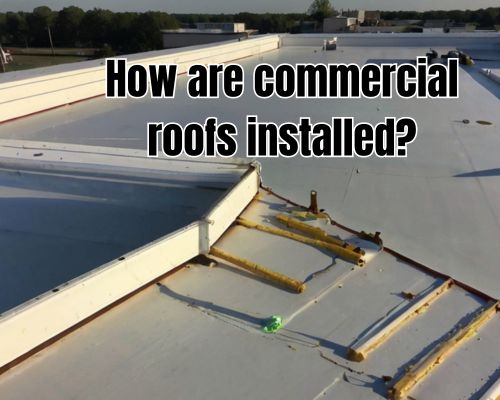- July 30, 2025
- By Rebecca Washington
- Uncategorized
How Are Commercial Roofs Installed? | A Guide for New Jersey Property Owners
In the dynamic world of commercial construction in New Jersey, one crucial question often emerges among business owners, facility managers, and developers: “How are commercial roofs installed?” While the process might seem straightforward, installing a commercial roof is a complex, multi-phase operation that requires precision, compliance with building codes, weather awareness, and industry expertise. Whether you’re managing a retail center in Newark, overseeing a warehouse in Trenton, or constructing a new commercial property in Jersey City, understanding the roof installation process can save you money, mitigate risks, and extend the roof’s lifespan.

With Charles Jimerson of CJ Commercial Roofing NJ, we’ll explore the step-by-step commercial roofing installation process, break down the materials and methods used, highlight local considerations specific to New Jersey’s climate, and explain why hiring certified commercial roofers in New Jersey is key to a long-lasting roofing system.
Step 1: Initial Roof Assessment and Planning
Before any physical work begins, licensed roofing contractors perform a site evaluation. This includes:
- Inspecting the existing structure (if it’s a replacement)
- Assessing building use (e.g., warehouse, retail, office)
- Determining local zoning requirements and New Jersey state building codes
- Identifying potential drainage issues and insulation needs
Roofing in New Jersey’s varied climate (cold winters, humid summers, nor’easters) means the roofing system must be energy-efficient, watertight, and built for thermal expansion and contraction.
At this stage, engineers and project managers also determine the best roofing system for the property. Common commercial roofing types include:
- TPO (Thermoplastic Polyolefin)
- EPDM (Ethylene Propylene Diene Monomer)
- Modified Bitumen
- Built-Up Roofing (BUR)
- PVC roofing membranes
- Metal roofing systems
Step 2: Tear-Off or Overlay
If the project involves a roof replacement, the team must decide whether to do a complete tear-off of the existing roofing system or add a roof overlay.
In New Jersey, state codes often limit overlays to a maximum of two layers. Going beyond this can violate regulations and increase structural load beyond safe limits—especially important for older brick-and-beam buildings common in Hoboken, Camden, and Paterson.
Tear-Off Benefits:
- Exposes hidden damage
- Allows for modern insulation upgrades
- Helps ensure full code compliance
Step 3: Substrate Preparation
A successful installation begins with a properly prepared substrate. Commercial roofers will:
- Remove loose debris
- Ensure the deck is dry and smooth
- Replace any water-damaged decking
- Apply a vapor barrier if needed
The substrate type (concrete, metal, or wood) will influence the choice of insulation and attachment method (mechanically fastened, fully adhered, or ballasted).
Step 4: Insulation Installation
Energy codes in New Jersey require that commercial roofs meet minimum R-value standards (R-30 or higher in many cases). Commercial roofers install rigid insulation boards in staggered layers to maximize thermal performance. Popular insulation materials include:
- Polyisocyanurate (ISO) – highest R-value per inch
- EPS (Expanded Polystyrene)
- XPS (Extruded Polystyrene)
Proper insulation not only reduces energy bills but also helps reduce heat island effects—a growing concern in dense urban zones like New Brunswick and Elizabeth, NJ.
Step 5: Roof Membrane Installation
Once insulation is installed, the waterproofing membrane is applied. Here are the most common systems used in New Jersey commercial roofing projects:
TPO Roofing (Highly Popular in NJ)
- White reflective surface reduces cooling costs
- Heat-welded seams create a durable bond
- Ideal for flat and low-slope roofs
EPDM Roofing
- Black synthetic rubber, known for flexibility and longevity
- Often ballasted or fully adhered
- Performs well in cold New Jersey winters
Modified Bitumen or BUR
- Often chosen for older buildings
- Multi-layered for added protection
- Installed using heat or cold adhesives
Contractors like CJ Commercial Roofing NJ ensure proper overlapping, sealing, and flashing around penetrations (vents, HVAC units, skylights), which is especially vital in coastal cities like Atlantic City prone to high winds and moisture.
Step 6: Drainage Systems and Edge Metal Installation
A well-functioning drainage system is crucial to prevent pooling water (ponding) that can degrade roofing membranes. Common drainage solutions include:
- Internal roof drains
- Scuppers
- Gutters and downspouts
New Jersey’s rainfall and snowmelt patterns demand well-designed drainage. Installers must account for freeze-thaw cycles, especially in northern areas like Morristown and Hackensack.
At this stage, edge metal (copings, fascia, gravel stops) is installed to protect the roof perimeter and complete the water management system.
Step 7: Quality Control & Final Inspection
Once the installation is complete, professional commercial roofers conduct:
- Moisture scans
- Infrared imaging
- Pull tests to check membrane adhesion
- Review of flashing, seams, and penetration seals
In many New Jersey municipalities, a final inspection by a local building authority is required before the roof can be certified for occupancy. It’s important to hire a contractor familiar with local permitting processes and inspection standards.
Step 8: Warranty & Maintenance Planning
Top-tier roofing contractors in New Jersey provide manufacturer-backed warranties ranging from 10 to 30 years. These often include labor and material coverage. Additionally, they offer roof maintenance programs that involve:
- Bi-annual inspections
- Debris removal
- Leak detection and repair
- Flashing and sealant touch-ups
A preventative maintenance plan is crucial given New Jersey’s seasonal extremes. Regular maintenance can extend roof life by 30% or more, especially in high-foot-traffic buildings like shopping malls and industrial centers.
Local Considerations for Commercial Roofs in New Jersey
- Snow Load Requirements: Northern NJ regions like Paramus and Parsippany often require higher structural support for snow accumulation.
- Wind Uplift Ratings: Coastal areas must meet stricter standards due to Atlantic hurricanes.
- Energy Efficiency Codes: Compliance with NJ Clean Energy Program® can yield tax incentives or rebates for energy-efficient roofing upgrades.
- Union Labor vs. Non-Union: Many large-scale projects in cities like Newark require union-certified crews due to labor regulations or developer agreements.
Why Hire Local New Jersey Commercial Roofing Experts?
Commercial roofing in New Jersey demands specialized knowledge of regional codes, weather patterns, and materials. Hiring a licensed local roofer offers advantages like:
- Faster permit approvals
- Familiarity with NJ DCA regulations
- Easier coordination with local suppliers
- On-the-ground knowledge of best practices
Top commercial roofing companies in New Jersey often hold certifications from manufacturers like GAF, Firestone, Johns Manville, and Carlisle SynTec, giving you peace of mind and premium warranty options.
Final Thoughts
So, how are commercial roofs installed? In a nutshell: through a highly coordinated, step-by-step process tailored to your building’s structure, purpose, and environment. From pre-planning and insulation to drainage and final inspection, the commercial roofing installation process in New Jersey is driven by strict codes, energy efficiency standards, and local weather demands.
Whether you’re in the early stages of planning or getting bids for replacement, understanding this process can help you make informed decisions, avoid costly mistakes, and invest in a durable roofing solution that stands up to New Jersey’s toughest conditions.
🛠️ Considering a commercial roofing project in NJ? Consult with local experts to ensure your installation is code-compliant, energy-efficient, and future-ready.




